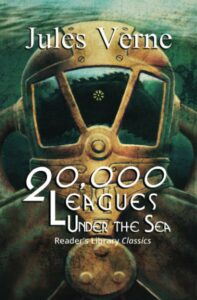
Book Summary
“20,000 Leagues Under the Sea” is an exciting adventure book written by Jules Verne. It takes you on an amazing journey under the sea with a group of brave explorers. Get ready to dive into a world full of mystery and wonder!
In this book, you will meet Professor Aronnax, a smart scientist, and his friends, Ned Land and Conseil. They set out on a mission to find a sea monster that has been causing trouble in the oceans. But instead of finding a monster, they discover a magnificent submarine called the Nautilus, which is captained by the mysterious Captain Nemo.
As they explore the depths of the sea, they encounter all sorts of incredible creatures like giant squids and colorful fish. They also visit amazing underwater landscapes and even explore a lost city! The adventures are thrilling and will keep you on the edge of your seat.
“20,000 Leagues Under the Sea” is a science fiction book that was written over 150 years ago. Jules Verne was a famous French author who was known for his imaginative stories. This book was way ahead of its time because submarines were not common back then.
The story teaches us about the wonders of the ocean and the importance of exploration. It also raises questions about the relationship between humans and nature. Captain Nemo, the captain of the Nautilus, has a complicated past and his actions make us think about the consequences of our actions on the environment.
The book is filled with detailed descriptions of the underwater world, which will make you feel like you are right there with the characters. It’s a great book for anyone who loves adventure and wants to learn more about the mysteries of the sea.
Jules Verne was a French author who lived from 1828 to 1905. He wrote many famous books that are still loved by readers today. Verne was known for his vivid imagination and his ability to create exciting adventures. He is often called the “Father of Science Fiction” because his stories were so innovative for their time. Verne’s books have been translated into many languages and have inspired countless movies and other works of art.
“20,000 Leagues Under the Sea” is a classic science fiction novel written by French author Jules Verne. Published in 1870, the book is a part of Verne’s acclaimed “Voyages Extraordinaires” series. The story is set in the late 19th century and follows the underwater adventures of Captain Nemo and his submarine, the Nautilus. The title refers to the distance traveled under the sea, not the depth, as 20,000 leagues is over six times the diameter of Earth.
“20,000 Leagues Under the Sea” is a thrilling adventure that combines scientific exploration with a captivating narrative. The novel is a testament to Verne’s imaginative prowess, as he vividly describes the underwater world, its flora and fauna, and the advanced technology of the Nautilus, which was far ahead of its time.
The story is narrated by Professor Pierre Aronnax, a French marine biologist who, along with his faithful servant Conseil and Canadian harpooner Ned Land, is captured by Captain Nemo. The trio is taken on a journey through the world’s oceans, witnessing the marvels of the deep and the dangers that lurk beneath the surface.
The novel is not just an adventure story; it also explores themes of freedom, revenge, and the human condition. Captain Nemo is a complex character, a man driven by a desire for knowledge and exploration, but also by a deep-seated hatred for humanity’s destructive tendencies.
“20,000 Leagues Under the Sea” is a pioneering work in the science fiction genre. Verne’s detailed descriptions of the submarine and its technology, as well as the underwater landscapes, were groundbreaking at the time of publication and continue to inspire awe.
The novel also delves into the psychological aspects of isolation and the human desire for freedom. Captain Nemo, despite his self-imposed exile from society, yearns for freedom and autonomy. This is reflected in his decision to live under the sea, away from the constraints of society.
The book also raises ethical questions about the use of technology and mankind’s relationship with nature. While the Nautilus represents human ingenuity and progress, it is also a weapon of destruction, reflecting Verne’s concerns about the potential misuse of technology.
Jules Verne (1828-1905) was a French novelist, poet, and playwright, best known for his adventure novels and his profound influence on the literary genre of science fiction. His other notable works include “Journey to the Center of the Earth” and “Around the World in Eighty Days”. Verne’s writing has been characterized by a scientific curiosity, a sense of wonder, and a deep understanding of human nature. His works have been translated into many languages and continue to be popular worldwide. Verne’s ability to predict new technological developments and his imaginative storytelling have earned him the title of “Father of Science Fiction”.
Don Quixote by Miguel de Cervantes
Miguel de Cervantes
Read Now →